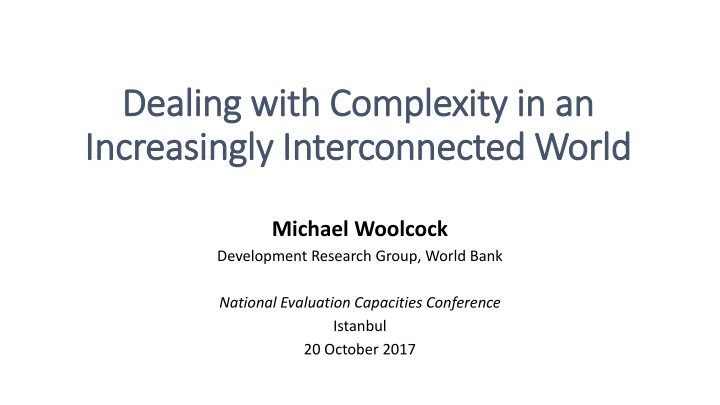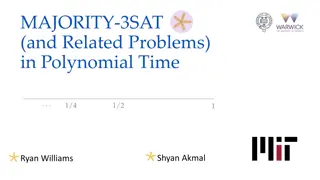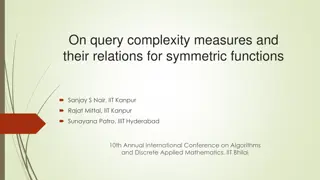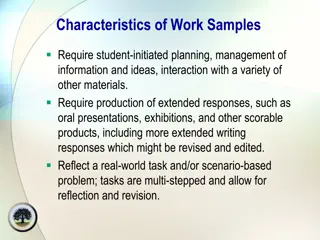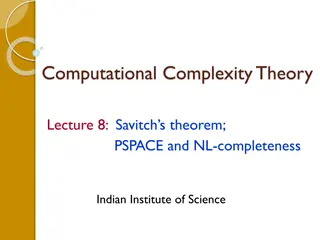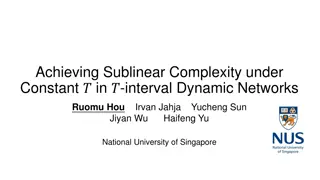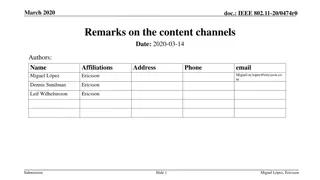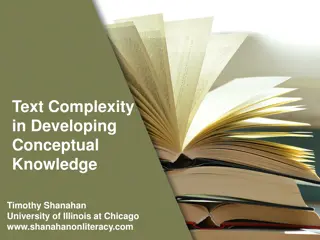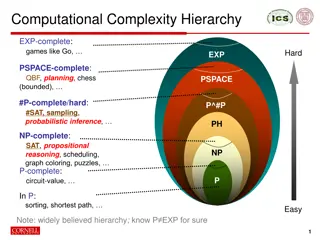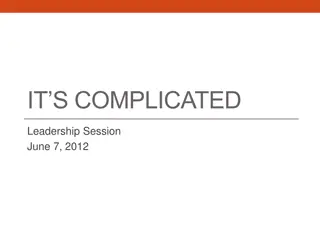Dealing with Complexity in an Increasingly Interconnected World
Dealing with complexity in today's interconnected world requires strategic decision-making based on rigorous evaluations. Explore real-world scenarios in Bolivia, Fiji, and India to understand the implications of scaling up interventions, exiting trade agreements, and assessing project effectiveness. Learn how data-driven insights can shape national initiatives and global rankings.
Download Presentation

Please find below an Image/Link to download the presentation.
The content on the website is provided AS IS for your information and personal use only. It may not be sold, licensed, or shared on other websites without obtaining consent from the author.If you encounter any issues during the download, it is possible that the publisher has removed the file from their server.
You are allowed to download the files provided on this website for personal or commercial use, subject to the condition that they are used lawfully. All files are the property of their respective owners.
The content on the website is provided AS IS for your information and personal use only. It may not be sold, licensed, or shared on other websites without obtaining consent from the author.
E N D
Presentation Transcript
Dealing with Complexity in an Dealing with Complexity in an Increasingly Interconnected World Increasingly Interconnected World Michael Woolcock Development Research Group, World Bank National Evaluation Capacities Conference Istanbul 20 October 2017
Pop quiz! Putting evaluations to work 1. In Bolivia, a carefully designed and implemented pilot intervention provides cash payments to poor rural families who send their 10-year-olds to school each day. A rigorous evaluation finds a significant improvement in the children s test scores. The education minister is keen to showcase a national flagship initiative, and has resources available. Do you advise her to scale up the pilot?
Pop quiz! Putting evaluations to work 1. In Bolivia, a carefully designed and implemented pilot intervention provides cash payments to poor rural families who send their 10-year-olds to school each day. A rigorous evaluation finds a significant improvement in the children s test scores. The education minister is keen to showcase a national flagship initiative, and has resources available. Do you advise her to scale up the pilot? A recent study published in a prestigious evaluation journal, using a large cross-country sample, finds that countries exiting from regional trade agreements significantly improve their rule of law score in subsequent years. Fiji s Minister of Justice desperately wants to improve his country s global ranking on the rule of law index, to encourage foreign investment. Do you advise him to push for Fiji s exit from its regional trade agreements? 2.
Pop quiz! Putting evaluations to work 1. In Bolivia, a carefully designed and implemented pilot intervention provides cash payments to poor rural families who send their 10-year-olds to school each day. A rigorous evaluation finds a significant improvement in the children s test scores. The education minister is keen to showcase a national flagship initiative, and has resources available. Do you advise her to scale up the pilot? A recent study published in a prestigious evaluation journal, using a large cross-country sample, finds that countries exiting from regional trade agreements significantly improve their rule of law score in subsequent years. Fiji s Minister of Justice desperately wants to improve his country s global ranking on the rule of law index, to encourage foreign investment. Do you advise him to push for Fiji s exit from its regional trade agreements? A randomized control trial (RCT) of a large women s empowerment project in Bihar (northern India) finds that, on average, the intervention had no effect after two years. Do you recommend shutting it down? 2. 3.
Pop quiz! Putting evaluations to work 1. In Bolivia, a carefully designed and implemented pilot intervention provides cash payments to poor rural families who send their 10-year-olds to school each day. A rigorous evaluation finds a significant improvement in the children s test scores. The education minister is keen to showcase a national flagship initiative, and has resources available. Do you advise her to scale up the pilot? A recent study published in a prestigious journal, using a large cross-country sample, finds that countries exiting from regional trade agreements significantly improve their rule of law score in subsequent years. Fiji s Minister of Justice desperately wants to improve his country s global ranking on the rule of law index, to encourage foreign investment. Do you advise him to push for Fiji s exit from its regional trade agreements? A randomized control trial (RCT) of a women s empowerment project in Bihar (northern India) finds that, on average, the intervention had no effect after two years. Do you recommend shutting it down? Small to Large 2. General to Specific ( There to Here ) 3. Interpreting Non-Impact In each case, the right answer is: It depends! But on what, exactly? What else do we need to know to provide better answers? How/where can we find it?
Evidenced Evidenced- -based Policy based Policy (as conventionally understood, at least by researchers ) Development policy, practice plagued by Inadequate, low-quality hard data Soft methodologies. Thus, Too much reliance on anecdotes , advocacy Lack of rigorous evidence on what works . As a result, Finite public resources deployed inefficiently Aid effectiveness debates fester, go unresolved Taxpayers, politicians remain skeptical, cynical Thus we need a more scientific , gold standard approach To do for development what RCTs did for medicine Elite researchers as white lab coat guys in development Really?
Improving decision-making in development [T]he bulk of the literature presently recommended for policy decisions cannot be used to identify what works here . And this is not because it may fail to deliver in some particular cases [; it] is not because its advice fails to deliver what it can be expected to deliver The failing is rather that it is not designed to deliver the bulk of the key factsrequired to conclude that it will work here. Nancy Cartwright and Jeremy Hardie (2012) Evidence-Based Policy: A Practical Guide to Doing it Better (New York: Oxford University Press, p. 137) What key facts do decision-makers need? How might these facts be acquired? For what kinds of interventions are these facts especially important?
Overview Overview 1.4 cheers for Evidence-based policy (As conventionally understood) Its virtues, its severe limits Complexity when everything is complex Defining characteristics of complex interventions Assessing their internal validity (net impact) Assessing their external validity (if it works there, then here?) Different challenges need different types of evidence Some examples The future of development is only more complex In poor, middle-income and rich countries alike Expanding the ecosystem of evaluation options
Evidence Evidence- -based policy: based policy: 1.4 cheers (at best) for all that 1.4 cheers (at best) for all that More, better data always desirable Sound methods always beat sloppy methods Accountability for use of public resources is vitally important Raising professional standards, meeting high expectations is a virtue Evidence-based Policy well-suited to accurately assessing standardized interventions (e.g., traffic flows) Such evidence can indeed yield best practices Some such best practices can be readily generalized, scaled
But also serious problems and limits But also serious problems and limits Not how today s rich countries became rich Not how today s rapidly growing poor countries accelerated Often hugely expensive, time-consuming Practitioners mostly need good-enough data now, not in three years Numerous ethical concerns, sometimes legitimate political resistance Potentially strong on answering whether something works, on average but often weak on How , why , for whom an intervention works Deciding between alternatives, optimizing under (many, vexing) constraints Discerning causes of effects (cf. effects of causes ) Building capability for policy implementation (cf. policy design) Generalizing, scaling: Will it work here? Will bigger be better?
Often inadequate for assessing complex interventions Often inadequate for assessing complex interventions Complexity when everything is complex Most complex interventions (or elements) characterized by: 1. High discretion (agency, choice) 2. Transaction-intensive (many face-to-face interactions) 3. Impose obligations (cf. deliver a service) 4. Unknown solutions to prevailing problems Which inherently yield highly variable outcomes: Over time, contexts, groups, implementing agencies e.g., schooling, justice, empowerment, governance How to more adequately assess such interventions?
Matching Matching types types of evidence to of evidence to types types of problems of problems Establishing causality is really hard, even in the actual world of white lab coats let alone let alone development interventions let alone complex development interventions Problems can be usefully arrayed by the nature, extent of their causal density the number of discretionary, human interactions involved i.e., from particle physics (zero) to medicine (some) to families (numerous)
Consider physics... Consider physics... Only the first nine pages in the 33-page article, published on 14 May in Physical Review Letters, describe the research itself including references. The other 24 pages list the [5154] authors and their institutions. The article is the first joint paper from the two teams that operate ATLAS and CMS, two massive detectors at the Large Hadron Collider (LHC) at CERN, Europe s particle-physics lab near Geneva, Switzerland. Each team is a sprawling collaboration involving researchers from dozens of institutions and countries. By pooling their data, the two groups were able to obtain the most precise estimate yet of the mass of the Higgs boson nailing it down to 0.25%.
Consider historical questions. Consider historical questions. Historians ask: What caused Historians ask: What caused The doctrine of the divine right of kings to fall? The advent of civil, human and gender rights? The Industrial Revolution? World War I? The end of slavery? of colonialism? of apartheid? Independence of Haiti, India, South Sudan? Lots of things so they tell a conjunctural causation story So too for complex development activities: careful process tracing and counterfactual reasoning can identify the sequence of causal mechanisms (inside the black box ) connecting certain variables (and not others) Absence of rigorous methodology is NOT why these problems aren t solved
Consider causality, extrapolation in medicine Consider causality, extrapolation in medicine ( moderate causal density) Extrapolating from RCTs in drug trials Rothwell (2005) The case of Black 6 Engber (2011), in Slate Black 6 turns out to be a teenaged, alcoholic couch potato with a weakened immune system, and he might be a little hard of hearing. Seok (2013), in NYT Years and billions of dollars compromised
Which sports are assessed most rigorously? Key point: Problems determine methods, not the other way around
Making, extrapolating impact claims Quality of empirical knowledge claims turns on 1. Construct validity Do key concepts ( property rights , poverty ) mean the same thing to different people? What gets lost in translation ? 2. Internal validity Controlling for other factors potentially shaping the result E.g., Selection effects: Programs rarely placed randomly 3. assessed against a theory of change How a project s components (and their interaction) and processes generate outcomes Reasoned Expectations: where by when? 4. External validity (how generalizable are the claims?) If it works here, will it work there? If it works with this group, will it work with that group? Will bigger be better? (Does 10x get you 10y?)
The internal validity challenge in complex projects The internal validity challenge in complex projects Outcomes inherently dependent on implementation capability By design, interact with / respond to context Huge unobserved heterogeneity Highly variable impact across time, space, groups Even when carefully designed, faithfully implemented, adequately funded, politically supported Can construct mean impact, but more insightful is the standard deviation No true counterfactual, except other instances of themselves Orthodoxy struggles to explain success and (especially) failure Unhappy projects are unhappy in their own way Absenteeism by District, Yemen % of All Employees absent 0% 10% 20% 30% 40% 50% 60% 70% 80% 90% Algobein 8% 18% 18% 20% 20% 20% Alsawadiah Alhaymah Aldak Mothikerah 23% 24% 25% 25% 25% 25% 27% 27% Alodein Alfaraa Alsadah Mazhar 29% 33% 33% 35% Hobeish Alqoraishiah 38% 38% 40% Yareem 49% 50% 50% 50% 50% 52% 52% Almakhader Manakhah Alqafr Alaymah Alkhar 67% 70% Bani Dhabian 73% 78% 80% 82% Kosmah Alttafah 83%
What to do? What to do? Endogenize research into implementation Experiment, learn, iterate, adapt India s Social Observatory (Vijayendra Rao et al) http://www.worldbank.org/en/programs/social-observatory A social science of delivery Global Delivery Initiative http://www.globaldeliveryinitiative.org/ Discern the causes of effects , not just effects of causes Understand how, for whom (not just whether) impact is achieved e.g., Process Evaluations, or Realist Evaluations e.g., Pawson; Rogers; Barron et al Knowledge claims require mixed methods, theory, and experience RCTs can be usefully deployed to assess certain aspects Complement to, not substitute for, orthodox approaches
Crucially, also need a theory of change Crucially, also need a theory of change When nothing seems to help, I go back and look at the stonecutter hammering away at his rock perhaps a hundred times without as much as a crack showing in it. Yet at the hundred and first blow it will split in two, and I know it was not that blow that did it but all that had gone before. Jacob Riis Sunflowers vs acorns
Understanding impact trajectories Net Impact t = 0 t = 1 Time
Understanding impact trajectories Same impact claim, but entirely a function of when the assessment was done Net Impact t = 0 t = 1 Time
Understanding impact trajectories B C A If an evaluation was done at A or B , what claims about impact would be made? Net Impact t = 0 t = 1 Time
Understanding impact trajectories B D C A Net Impact ? t = 0 t = 1 t = 2 Time
External validitys key facts 1. 2. 3. 4. Causal density of intervention(its type/level of complexity ) Implementation capability (can the designated agency do it?) Contextual compatibility (local legitimacy) Reasoned expectations (impact trajectory) Bottom line: if your intervention (say, justice reform) has high causal density requires high implementation capability has low contextual compatibility, and unfolds along an uncertain trajectory, then assume generalizability is low (probably zero). In this space, case studies and process tracing are essential tools.
Implications Implications Take the analytics of EV claims as seriously as we do IV Identification one issue among many needed for policy advice Expand the (vast) array of social science tools available for rigorously assessing complex interventions Within and beyond economics RCTs as one tool among many New literature on case studies (Gerring, ), QCA (Ragin), Complexity (Ramalingan) See especially realist evaluation (Pawson, Tilly) Make implementation cool; it really matters Learning from intra-project variation; projects themselves as laboratories, as policy experiments (Rondinelli 1993) Science of delivery must know how, not just whether, interventions work (mechanisms, theory of change) Especially important for engaging with complex interventions Problem-Driven Iterative Adaptation (PDIA) (Andrews, Pritchett, Woolcock 2013) Need counter-temporal (not just counterfactual) Reasoned expectations about what and where to be, by when?
Two applications Small to Big Local success that became a national failure (Brazil) Mediocre local project that became a global flag-bearer (Indonesia) Why? Interpreting Non-Impact Livelihoods project (India), assessed by RCT, yielded no overall effect Why? Common Lesson: Explaining (the past) and advising (the future) about both the effectiveness of complex interventions requires knowledge of key facts: * Design quality and characteristics * Context idiosyncrasies * Implementation capability All of which, in turn, requires integration of mixed methods, theory, experience
Suggested reading Ananthpur, Kripa, Kabir Malik and Vijayendra Rao (2014) The anatomy of failure: an ethnography of a randomized trial to deepen democracy in rural India World Bank Policy Research Working Paper No. 6958 Bamberger, Michael, Vijayendra Rao and Michael Woolcock (2010) Using Mixed Methods in Monitoring and Evaluation: Experiences from International Development , in Abbas Tashakkori and Charles Teddlie (eds.) Handbook of Mixed Methods (2nd revised edition) Thousand Oaks, CA: Sage Publications Bamberger, Michael, Jos Vaessen and Estelle Raimondo (eds.) (2015) Dealing with Complexity in Development Evaluation Sage Publications Bamberger, Michael, Jim Rugh and Linda Mabry (2013) RealWorld Evaluation: Working Under Budget, Time, Data and Political Constraints(2nd ed.) Sage Publications Barron, Patrick, Rachael Diprose and Michael Woolcock (2011) Contesting Development: Participatory Projects and Local Conflict Dynamics in Indonesia New Haven: Yale University Press Brixi, Hana, Ellen Lust and Michael Woolcock (2015) Trust, Voice and Incentives: Learning from Local Success Stories in the Middle East and North Africa Washington, DC: World Bank Woolcock, Michael (2009) Toward a Plurality of Methods in Project Evaluation: A Contextualized Approach to Understanding Impact Trajectories and Efficacy Journal of Development Effectiveness 1(1): 1-14 _____ (2013) Using Case Studies to Explore the External Validity of Complex Development Interventions Evaluation 19(3): 229-248 _____ (forthcoming) Reasons for Using Mixed Methods in the Evaluation of Complex Projects , in Michiru Nagatsu and Attilia Ruzzene (eds.) Philosophy and Interdisciplinary Social Science: A Dialogue London: Bloomsbury Academic
